ISSN ONLINE(2278-8875) PRINT (2320-3765)
ISSN ONLINE(2278-8875) PRINT (2320-3765)
Gayathri.S1, Subakaran.K2 , Somshekar.B3 , Rehman.S.K4, Ravi V Angadi5 , Dr Y Vijayakumar6
|
| Related article at Pubmed, Scholar Google |
Visit for more related articles at International Journal of Advanced Research in Electrical, Electronics and Instrumentation Engineering
The use of bearing is essential to all types of machines they provide the function of supporting heavier component in a desired position. These bearings have contact with the rotating part and causes surface wear which can be controlled by lubrication. Researchers have raised the standards of performance for rotating equipment by providing robust, cost effective, and easy to implement magnetic bearings in rotor can be more advantageous because its contact free resulting in no surface wear and hence no need for lubricant, no servicing and can work in clean environments, high speed applications, and position and vibration control and can withstand in extreme conditions. The present work is dealing with the modeling, investigations, simulation of active magnetic bearing using MATLAB and controlling of a specialized magnetic bearing system.
Keywords |
| Bearing; AMB ;Controller; Stator ; Rotor; Sensors; |
INTRODUCTION |
| The Active magnetic bearing (AMB) is a device that uses electromagnetic forces to support a rotor without mechanical contact. The use of magnetic forces to levitate a body without contact that a passive magnetic bearing is unstable. The instability problem in passive magnetic bearing occurs since the natural tendency of the stator is to attract the rotor until they come into contact. This problem lead to research work towards active systems. The term “active” implies that control action has been incorporated into the system to adjust the electromagnetic forces and maintain the rotor position control in order to overcome the negative stiffness effect so here in this paper, the use of a specialized bearing is taken into consideration. The bearing used is contactless with no abrasion and close to zero friction. There by it reduces noise and vibrations and give extreme life time expectancy. This paper reviews what is active magnetic bearing, MATLAB simulation of active magnetic bearing and the advantages, limitations and its applications. The capabilities of several major active magnetic bearing world manufactures are evaluated. |
II. OBJECTIVES |
| In an ever changing world, limits of current designs are constantly pushed further, requiring genuinely new ideas and technologies to meet new targets. Active magnetic bearings can make difference in both new designs and redesigns of existing ones. There are numerous advantages of using magnetic bearings, the most notable being contact-free, in that the magnetic force is used to support the object as opposed to contact between two surfaces. |
| ïÃÆü Simulation of active magnetic bearing using MATLAB |
| ïÃÆü Active magnetic bearings (AMB) have been designed to overcome the deficiencies of conventional journal or ball bearings. |
| ïÃÆü Ability to work in vacuums with no lubrication and no contamination, or to run at high speed, and to shape novel rotor dynamics. |
| ïÃÆü Magnetic bearings have been introduced into the industrial world as a very valuable machine element with quite a number of novel features, and with a vast range of diverse applications. |
III. BACKGROUND OF THE SYSTEM |
| Existing engine systems are supported by bearings and dampers, which are limited in speed and temperature (<260*C). Additionally, these systems require complicated secondary cooling paths and an intricate lubrication system. These components significantly increase the weight, complexity and cost. We have conventional bearings like ball bearing, roller bearings, surface fatigue are shown in below fig.1. All this produces large amount of frictional loss, wear and tear of the equipment and this leads to reduction in speed of shaft and efficiency of the system. |
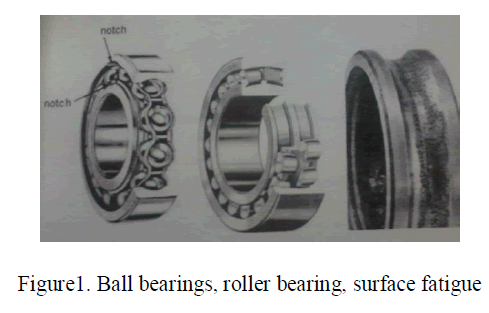 |
| The evolution of active magnetic bearings may be traced through the patents issued in this field. Earlier patents for magnetic suspensions can be found but are excluded here because they consist of assemblies of permanent magnets of problematic stability per Earnshaw’s theorem. Thus the need for large thrust bearings are eliminated which can then be replaced by magnetic thrust bearing, conventional active magnetic bearing system, whether electromagnet bias or permanent magnet bias, typically utilize three actuators for 5-axis system. This would be in the form of two radial actuators, each supporting and controlling two radial axes, and a thrust actuator supporting and controlling and controlling a single axial axis[1]. Each actuator axis functions independently to provide forces in its defined axis for table support and control of the levitated shaft, the controlling force should be balanced. |
IV. PROPOSED SYSTEM |
| An active magnetic bearing system supports a rotating shaft, without any physical contact by suspending the rotor in the air, with an electrically controlled magnetic force. It is a mechatronic product which involves different fields of engineering such as mechanical, electrical, control system, and computer science etc. |
| Active magnetic bearing have several attractive advantages over conventional bearings because magnetic bearings levitate rotors and therefore have no physical contact with the spinning rotors [1]. The use of magnetic bearings can significantly eliminate the frictions that usually exist in conventional bearings. Thus, in rotating systems, magnetic bearings can contribute to efficiency in energy, longer life, and the ability to operate at very high RPM. Other advantages include the elimination of mechanical maintenance of the bearing and lubrication, suitability for clean or vacuum room operation. The physical arrangement is shown in the below fig 2 & 3 respectively. |
| The programmable feature typically includes the ability to adjust stiffness, damping, and periodic force as function of time or other parameters such as bearing temperature, RPM and angular acceleration. Active magnetic bearings have been implemented in rotating systems in a variety of industrial application. |
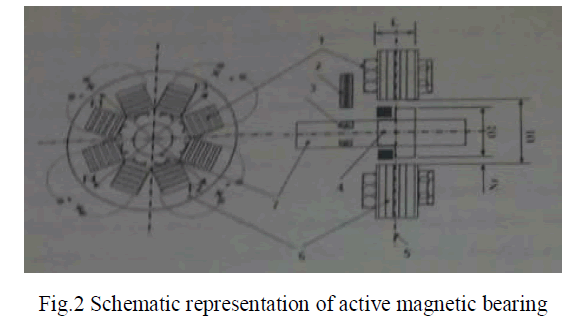 |
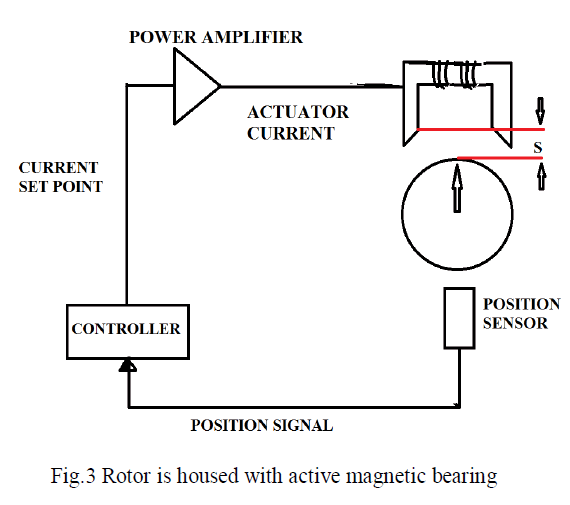 |
V. PRINCIPLE OF OPERATION |
| Magnetic bearings works on the principle of electromagnetic suspension and consists of an electromagnet assembly, a set of the power amplifiers which supply current to the electromagnets, a controller, and gap sensors with associated electronics to provide the feedback required to control the position of the rotor within the gap. |
| An active magnetic bearing (AMB) consists of an electromagnet assembly, a set of power amplifiers which supply current to the electromagnets, a controller, and a gap sensors with associated electronics to provide the feedback required to control the position of the rotor within the gap. The power amplifier supplies equal bias current to two pairs of electromagnets on opposite sides of the rotor [4]. This constant tug-of-war is mediated by the controller due to control current as the rotor deviates by small amount from its center position. |
| Basic operation for a single axis Active magnetic bearing consists of an electromagnet assembly, a set of power amplifiers which supply current to the electromagnets, a controller, and a gap sensor with associated electronics to provide the feedback required to control the position of the rotor within the gap. The elements are shown in the diagram. The power amplifiers supply equal bias current to two pairs of electromagnets on opposite sides of a rotor [3]. This constant tug-of-war is mediated by the controller which offsets the bias current by equal but opposite perturbations of current as the rotor deviates by a small amount from its center position. The gap sensors are usually inductive in nature and sense in a differential mode. The power amplifiers in a modern commercial application are solid state devices which operate in a pulse width modulation (PWM) configuration. The controller is usually a microprocessor or DSP. |
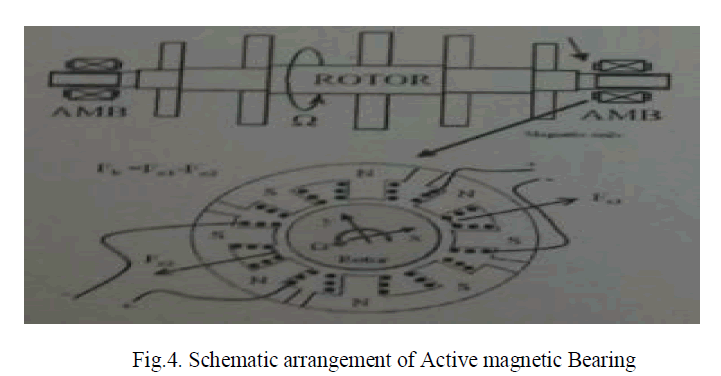 \ \ |
| Function principle of the active magnetic bearing is shown in the above fig.4. and also shows the basic components of a magnetic bearing and its working principle. A magnetic rotor is suspended by an electromagnet. In order to get an active control of the rotor, its position is measured by a position sensor. The position signal is then treated by a controller, which gives a current set point. This signal is then amplified by the power amplifier, in order to get the necessary actuator current. A closed loop control is thus realized and the system can be stabilized. This single actuator enables the levitation along only one axis and only in one direction. In AMB system, several actuators are used in order to control the rotor levitation along several degrees-of-freedom (DOF). Actuators are typically arranged as pairs facing each-other. This enables to attract the rotor in two opposite directions along one axis. |
| These are requiring a specialized control and software. They are comprised of three distinct parts the bearing itself, the electronic control system, and the auxiliary bearings. The purpose of the electronic control system is to control the position of the rotor by varying the current in the electromagnets. The electronic control system can be adjusted and adapted to the disturbance frequency of the machine itself. This information can be used to adjust and optimize performance due to process changes. Active magnetic bearings have higher stiffness and damping characteristics than similar size passive bearings. |
| The auxiliary bearings are used to support the rotor when the machine is stationary with the electronic control system switched off, or in the event of a failure in the magnetic suspension system to allow the rotor to run down without damage to the rotor itself or the stator of magnetic bearings. |
VI. AMB COMPONENTS |
| The basic AMB components are shown in above figure.4. Electromagnets are composed of a soft magnetic core and electrical coils. They look somewhat like the stator of an electrical motor is shown in the below fig.5. |
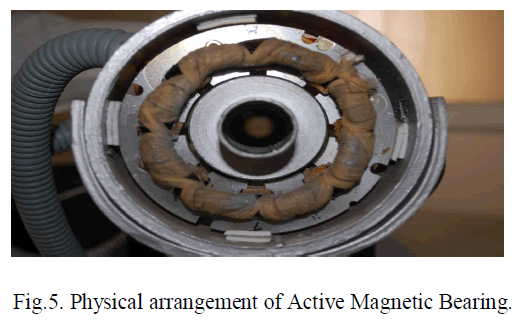 |
| 1. Iron core: |
| The iron core is a material conducting the magnetic field to the air gap. Its magnetic permeability has to be high, as well as its magnetic saturation. In order to minimize eddy current losses, the core usually consists of insulated lamination sheets. |
| 2. Windings: |
| The current through the winding is the source of magnetic field. The winding is made of an insulated conductor wound on the soft magnetic core. In order to improve the efficiency of the AMB, the conductor has to have a low electric resistance and must be wound with a high fill-factor. |
| 3. Rotor: |
| The rotor is standard construction, is realized with lamination packet shrinked on a nonmagnetic shaft. Tight manufacturing tolerances are needed in order to avoid unbalances. The mechanical properties of the rotor lamination have to be good, in order to overcome the centrifugal stress due to high speed rotation. |
| 4.Position sensors: |
| In most applications, there position sensors in AMBs. Since AMBs are actively controlled regarding to the sensor signal, the control performance strongly depends on the sensor performance. The physical arrangement of sensor arrangement is shown in below fig.6.Several sensor types are used in AMBs: inductive, eddy current, capacity and optical displacement sensors. The sensor consists of sensitive elements located on the stator and an acting element located on the rotor in the front of sensitive elements. |
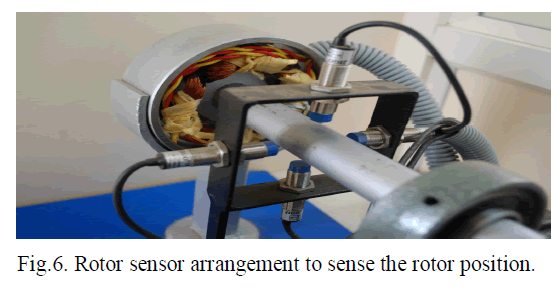 |
| The sensitive element in an annular magnetic circuit with 24 poles, of which each 6 poles are grouped to detect the radial displacements in X and Y directions. In such design, a kind of 2/3 redundancy working mode for the sensor signals can be easily realized. The acting element is an extension made of the laminated ferromagnetic steel, which is fixed on the turbo machine shaft. Windings around the stator perimeter are distributed in order to average and smooth the measure value. This kind of sensor has good sensitivity of no less than 10m/um and resolution of at least 1um. Its cut-off frequency is enough so high (>5 kHz) that the phase lag at operation frequency can be neglected. The voltage signal after the sensor modulator can be transferred more than 200m without obvious attenuation. |
VII. ANALITICAL MODEL OF AMB |
| This section provides a brief review of analytical model found based on the physical laws of magnetic bearing. An analytical model is needed in model based control system design the physic governing the AMB can be described by differential equation which represent the motion of MB in response to the input signal .this will be in the form of state space, model of the system keeps the form of: |
| X=Ax+Bu |
| Y=Cx+Du |
| Where x is the state vector .u is system input vector. y is system output vector. A,B,C&D is matrices described system mathematically for the magnetic bearing system the analytical derivation is broken in to two part ‘rigid body’& ‘bending body’ . When the system act as the rigid body it means that it is completely in flexible when the system act as bending body it means that it is bending body. Then mat lab will be use to compile the model this magnetic bearing system contains the stainless steel shaft. The stainless steel can levitate using 8 horseshoe electro magnet with 4 each side has a shaft. Hall Effect sensor place just outside of electromagnet at each ends of shaft to measure shaft displacement. The force/Moment relationship is shown in the below fig.7. The 4degree of freedom are broken in to two translational degrees also included in the magnetic bearing are 4 onboard controllers which levitates he bearing when the controllers are connected in feedback. There also 4 switch on the front panel of magnetic bearing to disconnect each of the controllers so that any one or all of them can be replaced by an external controller. |
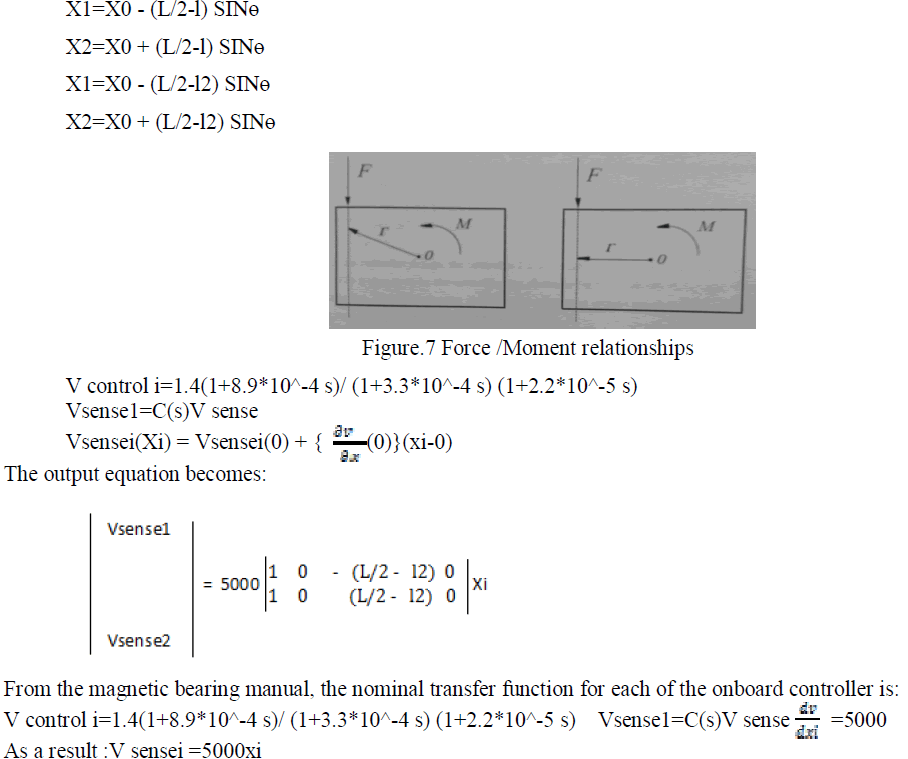 |
VIII.CONTROLLING ACTION DESIGNED BY SIMULINK MODELS USING MAATLAB |
| Now that the lead compensator clead2(s) and notch filters N1(s) and N2(s) have been designed, the whole system can be simulated using SIMULINK .The bending state space model will be used to represent the bearing system dynamics. the rigid body model will not be used in the simulation as the real system does have distinct resonant modes. The below figure.8 shows the MATLAB SIMULINK simulation window with all the required blocks. Note that only the x direction is taken into account , ,hence channel 1 and channel 2 only are included in the simulation[2] .For channel 1,c(s) is used and clead2(S) for channel 2.The two outputs vsense1 and vsense2 can be plotted for a step input. |
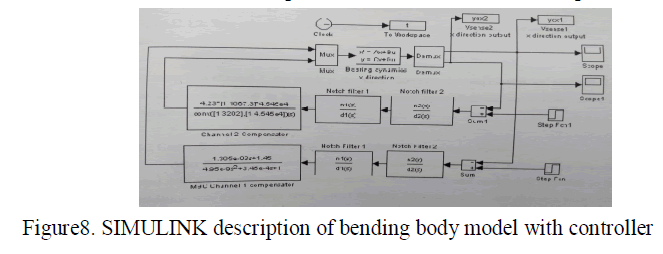 |
| For a step input of magnitude 0.001 applied to channel 1 at time t=0, the conventional controller and the two notch filters to stabilize the magnetic bearing system initially .Investigation has revealed that the two notch filters designed based on the analytical model did not notch out the resonant at the two exact resonant frequencies .As a result the two notch filters have to be redesigned to cover a wide frequency range around the two resonant frequencies. The magnetic bearing output response is given in figure after the redesign of the two notch filters. Note that the system is stable with a large overshoot to begin with. |
 |
| For input into channel 2,the result is the same, however the magnitudes are reversed. The fig.8 was the expected result as the designed conventional controllers and notch filters stabilized both channels successfully. |
IX. CONTROLLER SIMULATION USING THE IDENTIFIED EXPERIMENTAL MODEL |
| After the controller had been tested with the analytical model, the controller was also tested with the identified experimental model. The experimental model that was used in the simulation was the reduced order model great (s).The assumption was that if a reasonable response was achieved, then the experimental implementation would be successful. The figure.10 shows the SIMULINK block diagram containing the specified model obtained via system identification ,the designed lead compensator and notch filter .A step input of magnitude 0.001 occurring at t=0 was applied for 1 second and the response that was obtained is plotted .The horizontal scale is not in seconds, the plot shown occurred over 0.1 seconds .notice that the system showed is not stability ,and therefore it can be concluded that the designed controller should theoretically work on the real system .the reason behind this claim is that identified experimentally model is the closest estimate to the real system. |
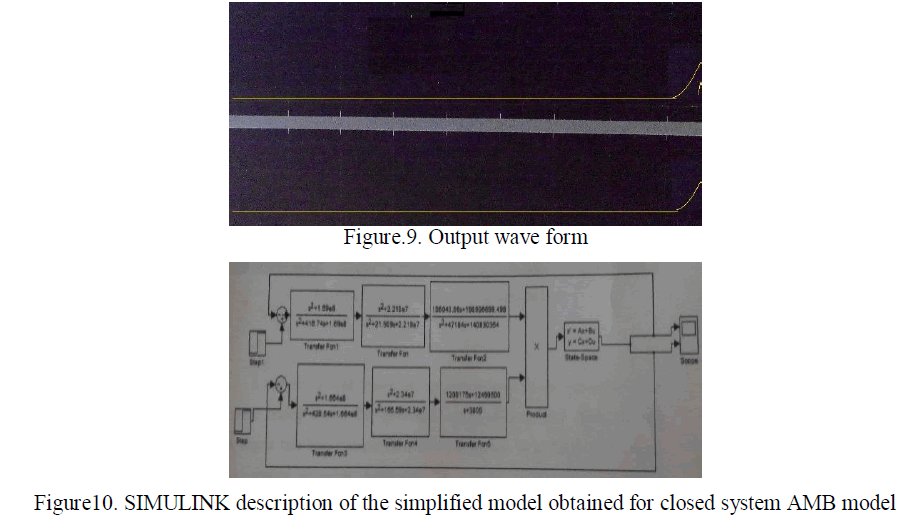 |
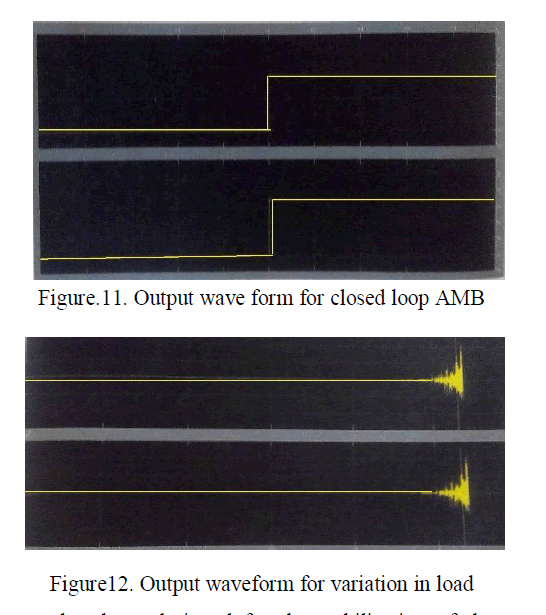 |
| A conventional lead compensator has been designed for the stabilization of the magnetic bearing system .The performance of the designed notch filters and lead compensator have been evaluated via simulator using both the analytical model and the model obtained via system identification .The simulation results have shown in the above fig 9, 10 & 12 output waveform of controller, closed loop operation of active magnetic bearing and load varies output waveforms respectively, that the designed notch filter and lead compensator have stabilized the magnetic bearing system success. Thus we can easily achieve the controlling of active magnetic bearing. |
CONCLUSION |
| Through technical advances ,magnetic bearing offer advantage for a much border range of machines and applications design innovation related to miniaturization ,integration and standardization continue to increase the general acceptance of magnetic bearing for many new and existing applications setting standard for better ,smaller and greener. Historically, the relatively high cost of magnetic bearing has limited the technologies and application however through the standardization integration and manufacturing advances ,the cost of magnetic bearing has declined while the engineering effort to develop new magnetic bearing system is often higher than past system the net result is the magnetic bearing has become much more economical to use in new and existing rotating machinery. |
References |
|